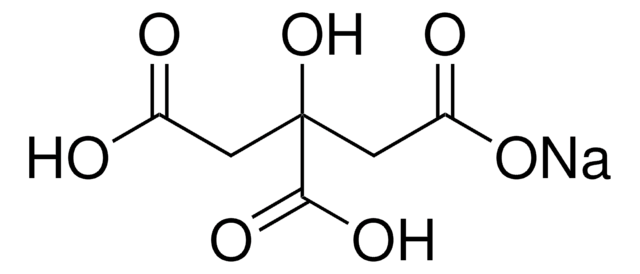567446
Citrato de sodio tribásico dihydrate
Molecular Biology Grade
Sinónimos:
Citrato de trisodio dihydrate, Ácido cítrico trisodium salt dihydrate
About This Item
Productos recomendados
grado
Molecular Biology
Nivel de calidad
Análisis
≥99% (titration)
formulario
crystalline solid
fabricante / nombre comercial
Calbiochem®
condiciones de almacenamiento
OK to freeze
color
white
pKa (20 °C)
6.40
mp
>300 °C (lit.)
solubilidad
water: 100 mg/mL
trazas de catión
heavy metals: ≤0.001%
heavy metals (as Pb): ≤0.001%
absorción
≤0.015 at 260 nm
≤0.015 at 280 nm
actividad extraña
DNases, proteases, RNases, none detected
Condiciones de envío
ambient
temp. de almacenamiento
15-25°C
cadena SMILES
O.O.[Na+].[Na+].[Na+].OC(CC([O-])=O)(CC([O-])=O)C([O-])=O
InChI
1S/C6H8O7.3Na.2H2O/c7-3(8)1-6(13,5(11)12)2-4(9)10;;;;;/h13H,1-2H2,(H,7,8)(H,9,10)(H,11,12);;;;2*1H2/q;3*+1;;/p-3
Clave InChI
NLJMYIDDQXHKNR-UHFFFAOYSA-K
¿Está buscando productos similares? Visita Guía de comparación de productos
Descripción general
Aplicación
- Study on the preparation of ascorbic acid reduced ultrafine copper powders in the presence of different protectants and the properties of copper powders based on methionine protection.: This research utilizes sodium citrate dihydrate as a protective agent in the synthesis of ultrafine copper powders, enhancing their stability and properties for potential applications in catalysis and electronics (Ke X et al., 2024).
- Optimization of micro-QuEChERS extraction coupled with gas chromatography-mass spectrometry for the fast determination of phthalic acid esters in mussel samples.: Sodium citrate dihydrate is employed in the extraction process for the detection of phthalic acid esters in mussels, demonstrating its effectiveness in analytical chemistry and environmental monitoring (Carro N et al., 2023).
- New butanolide derivatives from the marine derived fungus Aspergillus terreus GZU-31-1 by chemical epigenetic manipulation.: This study highlights the role of sodium citrate dihydrate in the isolation and characterization of new bioactive compounds from marine fungi, contributing to natural product research and drug discovery (Zhou Y et al., 2024).
- PEGylated Gold Nanoparticles Grafted with N-Acetyl-L-Cysteine for Polymer Modification.: Sodium citrate dihydrate is used as a reducing agent in the synthesis of PEGylated gold nanoparticles, which are then applied for polymer modification, highlighting its applications in nanotechnology and materials science (Fajstavr D et al., 2021).
- Characterization of sodium tripolyphosphate and sodium citrate dehydrate residues on surfaces.: This research focuses on the characterization of residues of sodium citrate dihydrate on surfaces, providing insights into its applications in surface chemistry and industrial cleaning processes (Gurses MS et al., 2018).
Advertencia
Reconstitución
Información legal
Código de clase de almacenamiento
11 - Combustible Solids
Clase de riesgo para el agua (WGK)
WGK 1
Punto de inflamabilidad (°F)
Not applicable
Punto de inflamabilidad (°C)
Not applicable
Certificados de análisis (COA)
Busque Certificados de análisis (COA) introduciendo el número de lote del producto. Los números de lote se encuentran en la etiqueta del producto después de las palabras «Lot» o «Batch»
¿Ya tiene este producto?
Encuentre la documentación para los productos que ha comprado recientemente en la Biblioteca de documentos.
Los clientes también vieron
Nuestro equipo de científicos tiene experiencia en todas las áreas de investigación: Ciencias de la vida, Ciencia de los materiales, Síntesis química, Cromatografía, Analítica y muchas otras.
Póngase en contacto con el Servicio técnico


